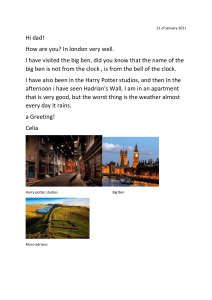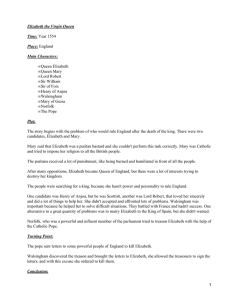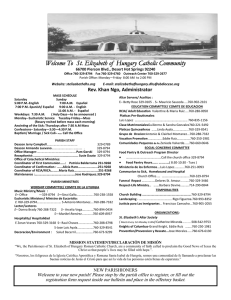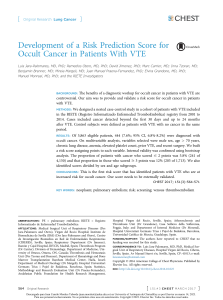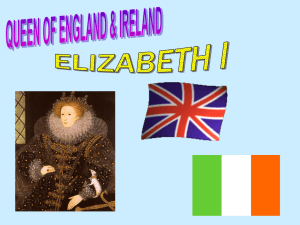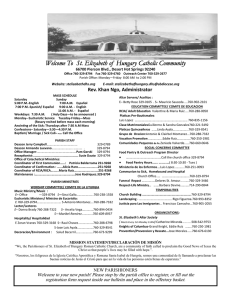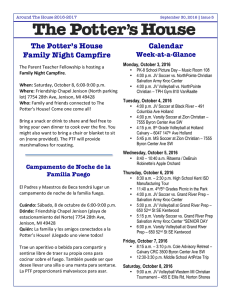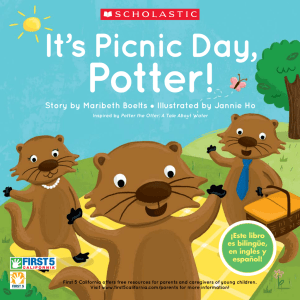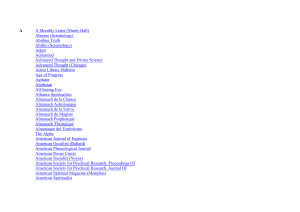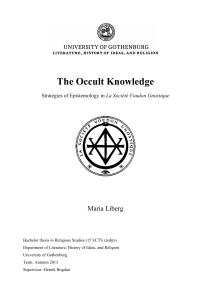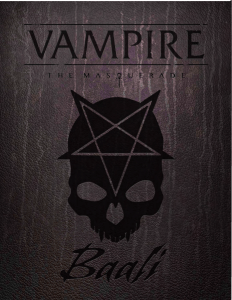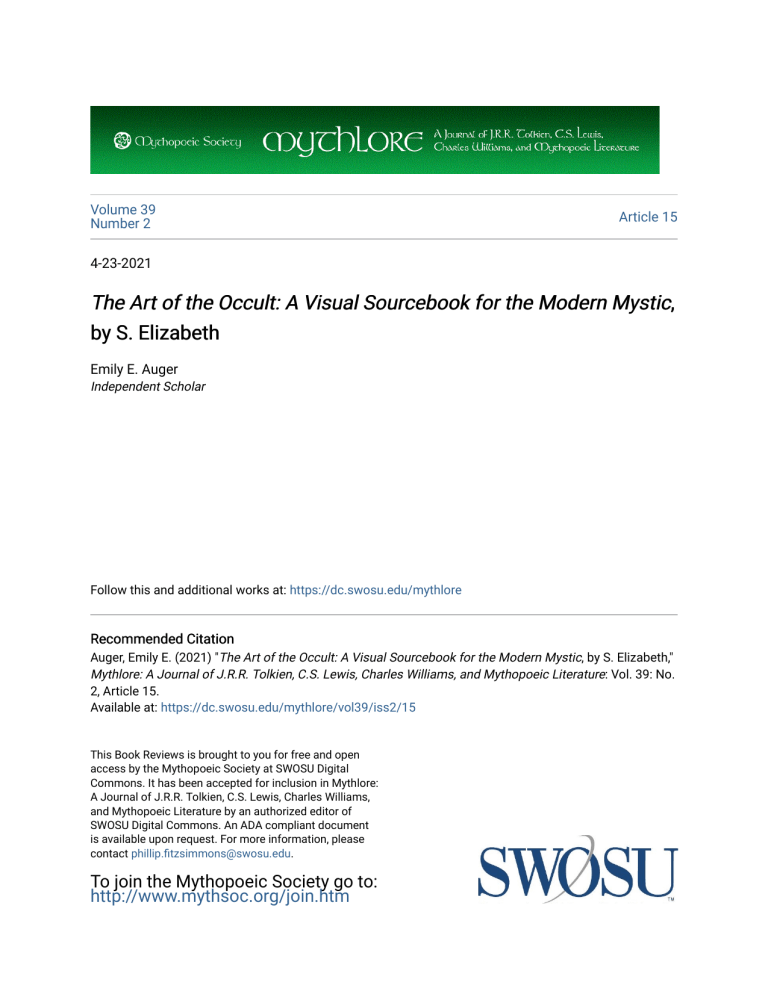
Volume 39 Number 2 Article 15 4-23-2021 The Art of the Occult: A Visual Sourcebook for the Modern Mystic, by S. Elizabeth Emily E. Auger Independent Scholar Follow this and additional works at: https://dc.swosu.edu/mythlore Recommended Citation Auger, Emily E. (2021) "The Art of the Occult: A Visual Sourcebook for the Modern Mystic, by S. Elizabeth," Mythlore: A Journal of J.R.R. Tolkien, C.S. Lewis, Charles Williams, and Mythopoeic Literature: Vol. 39: No. 2, Article 15. Available at: https://dc.swosu.edu/mythlore/vol39/iss2/15 This Book Reviews is brought to you for free and open access by the Mythopoeic Society at SWOSU Digital Commons. It has been accepted for inclusion in Mythlore: A Journal of J.R.R. Tolkien, C.S. Lewis, Charles Williams, and Mythopoeic Literature by an authorized editor of SWOSU Digital Commons. An ADA compliant document is available upon request. For more information, please contact [email protected]. To join the Mythopoeic Society go to: http://www.mythsoc.org/join.htm Online Summer Seminar 2023 August 5-6, 2023: Fantasy Goes to Hell: Depictions of Hell in Modern Fantasy Texts https://mythsoc.org/oms/oms-2023.htm The Art of the Occult: A Visual Sourcebook for the Modern Mystic, by S. Elizabeth This book reviews is available in Mythlore: A Journal of J.R.R. Tolkien, C.S. Lewis, Charles Williams, and Mythopoeic Literature: https://dc.swosu.edu/mythlore/vol39/iss2/15 Reviews But that is a quibble. Overall, this book presents an original idea about Beatrix Potter that connects her in a new way to the great soup of stories. I highly recommend it for anyone who is interested in Beatrix Potter and her tales. —John Rosegrant WORKS CITED Freud, Sigmund. “Remarks on the theory and practice of dream interpretation.” In The Standard Edition of the Complete Psychological Works of Sigmund Freud. Ed. James Strachey. Hogarth, 1961. (Originally published 1923.) Vol. 19, 109-124. Grinstein, Alexander. The Remarkable Beatrix Potter. International Universities Press, 1995. Lane, Margaret. The Tale of Beatrix Potter. Frederick Warne, 1946. Lear, Linda J. Beatrix Potter: A Life in Nature. St. Martin’s, 2007. Potter, Beatrix. Beatrix Potter’s Letters. Ed. J. Taylor. Frederick Warne, 1989. —. Beatrix Potter: The Complete Tales. Frederick Warne, 2012. —. The Journal of Beatrix Potter 1881-1897, edited by Leslie Linder, Frederick Warne, 1989. Scheftel, Susan. “The child’s child: theory of mind in the work of Beatrix Potter.” American Imago, vol. 71, no. 2, summer 2014, pp.161-172 Tolkien, J.R.R. “On Fairy-stories.” The Tolkien Reader. Ballantine, 1983, pp. 33-99. Tuerk, Richard. “Dorothy’s Timeless Quest.” Mythlore, vol. 17, no. 1, 1990, pp. 20-24. Tutter, Adele. “‘To half believe and wholly play’: dialectics of reality in Beatrix Potter’s The Tale of Two Bad Mice.” American Imago, vol. 71, no. 2, summer 2014, pp. 133-160. T HE A RT OF THE O CCULT : A V ISUAL S OURCEBOOK FOR THE M ODERN M YSTIC . S. Elizabeth. White Lion Publishing, 2020. 240 pp. including a one-page list of books for further reading, two-page index consisting primarily of artist’s names, credits, acknowledgements, and 200 colour illustrations. Hardcover ISBN 978-0-7112-4883-0 $29.99; Ebook ISBN 978-0-71125416-9. S . ELIZABETH, AUTHOR OF THE ART OF THE OCCULT, is the online pseudonym for Sarah Walters, whose credentials include writing for the website “Haute Macabre,” her blogs “Ghoul Next Door” and “These Unquiet Things,” and now The Art of the Occult, published by White Lion Publishing, one of the Quarto Group’s numerous imprints specializing in well-illustrated general interest books. This volume is exactly what its subtitle announces: A Visual Sourcebook for the Modern Mystic, and it is one of several new releases attracting social media buzz in 2020, the first year of COVID-19. This beautiful book full of colour pictures on an increasingly trendy subject held much promise as a refreshing Mythlore 39.2, Spring/Summer 2021 177 Reviews antidote to wearying digital interfaces and news broadcasts attaching unthinkable numbers to the death tolls, ICU units, and contact tracing of this debilitating and often deadly virus. At least some of the millions in quarantine or self-isolation were delighted when The Art of the Occult became available just in time for on-line Christmas shopping in 2020; their enthusiasm for occult subject matter—which includes alchemy—undoubtedly segueing rather well with predictions that the not-so-magical vaccine promised (and delivered) by modern science would arrive at the very moment heralded by astronomical phenomena. I am among those lucky enough to be safely and contentedly focused on home-alone projects during this time of crisis. The Art of the Occult caught my attention when a Facebook friend posted the cover showing a work by Hilma Af Klint (1915) that I used to show to my art history students. It made me feel nostalgic for classrooms and lecture halls where no one ever thought about wearing a mask or heading out the door because someone coughed. I was not particularly optimistic about the book itself; but then good things come in the mail these days, so, like many others, I awaited my copy with considerable, if guarded, anticipation. Indeed, S. Elizabeth is no James Wasserman, and anyone looking for a new and improved version of his Art and Symbols of the Occult: Images of Power and Wisdom (Destiny Books, 1993) will be disappointed. Those prepared to take Elizabeth’s book on its own terms should be delighted. Wasserman’s classic includes chapters on Astrology and Cosmology, Kabbalah and the Tree of Life, Initiation, Magic and the Gods, Sexuality, Alchemy, Tarot, and Symbolist and Visionary Art. Elizabeth avoids imitation in her organization of similar subjects by including three main sections, each of which has four chapters with titles focusing on aspects of art and “artistic spirit.” The Cosmos, for example, includes chapters on geometry, astrology, the elements, and alchemy, which are respectively titled “The Very Shape of Things: Sacred Geometry in Art,” “Gazing at the Stars: Astrology and the Zodiac in Art,” “The Imagery and Inspiration of the Elements,” and “Alchemy and Artistic Spirit.” The second section—Higher Beings—includes chapters on Gods and immortals, the Kabbalah, Theosophy, and the Hermetic tradition; and the third— Practitioners—includes chapters on witches and witchcraft, spiritualism, divination, and ceremonial magic. Wasserman provides a considerable amount of informative and historical text and lots of colour illustrations. Elizabeth offers less information and history, but the illustrations (identified by artist, title, date, and medium, no dimensions) are accompanied by her carefully composed and researched labels, some of which hint at the feeling of treasure hunting all good researchers are familiar with. Of “Astrological Diagrams” (45), she records: 178 Mythlore 138, Spring/Summer 2021 Reviews I initially spied these Persian astrological diagrams with reference to their inclusion in the 1966 book of striking occult imagery, History of Occult Sciences, written by engineer and historian of alchemy and Freemasonry, René Alleau (1917–2013). Further research revealed that they originated in The Book of Fixed Stars, an astronomical text written by Abd al-Rahman al-Sufi, c. 964. The diagrams illustrate different cultures’ converging of ideas of astrology. (45) Students will have to look elsewhere for in-depth information and history, but The Art of the Occult may well inspire them to do so. Elizabeth’s book includes numerous medieval works and many classics by artists familiar to the Western art history canon: Leonora Carrington (57, 74, 160), Albrecht Durer (179), Leonor Fini (178), Henry Fuseli (168-9), Francisco Goya (167), Hildegard of Bingen (31), Paul Klee (184), Wassily Kandinsky (42), Remedios Varo (84, 170), and John William Waterhouse (103, 183, 210), are just a few of the better known. I was pleased to see some of my particular favorites: Jean Deville’s “Portrait of Mrs Stuart Merrill” (1892) (126); one of Mondrian’s abstractions (21), as well as his “Evolution” (1911) (128); the Italian Futurist Luigi Carolo Filippo Russolo’s “Music” (1911) (129); the Orphist Frantisek Kupka’s “Centre Cosmique” (1932-33) (139); works by Emil Bistrram (133), Agnes Pelton (138), and of course, Hilma af Klint (22, 193). Klint’s “The Tree of Knowledge” (1913) was a special delight, as it calls to the mind’s eye a plethora of mythopoeic images related to that archetype, including Nancy-Lou Patterson’s equally evocative world tree drawings (see next page). For Tarot enthusiasts there are a couple of drawings by Aleister Crowley (154, 233), a discarded version of the Magus Tarot card by Frieda Lady Harris (155), a drawing from Arthur E. Waite’s book Ceremonial Magic (1911) (161), and two Tarot cards: Salvador Dali’s Death (212) and Pamela Colman Smith’s Queen of Pentacles (212). Many of the drawings and paintings acquire a new vibrance by their compilation and sometimes direct juxtaposition with others on similar themes, often from different centuries, but some of the mid-twentieth century and more recent works do not come off well in this context. Barnett Newman’s zip painting “Abraham” (123) succeeds primarily as an advertisement for the reductive absurdities of modernist aesthetics, and unfortunately, William Jones’s undated oil painting titled “Hermetic” (152) looks like a Navajo sand painting and serves primarily to evoke thoughts of the genuine article and its associated practices and beliefs. Even without a lot of explanatory text, the Medieval through nineteenth-century paintings convey a sense of living traditions and practices, while a few of the more recent works look like ornamental mood pieces, or, to the cynical eye, like parodies. These effects are bonuses insofar as they are reflections of the art as well as the history of the Mythlore 39.2, Spring/Summer 2021 179 Reviews content of that art: modern science, after all, has co-opted many of the practices and traditions that now fall under the heading of “occult,” and photography and computergenerated schematics have replaced hand-drawn illustrations in scientific texts. Even so, some opportunities were clearly missed. The Golden Dawn continues to be one of the most, if not the most influential “occult” tradition in the western world and it receives very scant attention, even by this book’s standards (226). And where are the contemporary Tarot Nancy-Lou Patterson. World Tree drawing, detail from promotional flyer for exhibition at Lynnwood Arts Center, Ontario, 1976. Hilma af Klint, The W Series, Tree of Knowledge, No. 1 (Serie W, Kunskapens träd, nr 1), 1913. Watercolor, gouache, graphite, metallic paint, and ink on paper, 45.7 x 29.5 cm. The Hilma af Klint Foundation, Stockholm. Photo: Albin Dahlström, Moderna Museet, Stockholm 180 Mythlore 138, Spring/Summer 2021 artists, such as Robert Place and Rachel Pollack, whose work reflects a deep interest and examination of alchemy in both its ancient and its modern psychological context? Dali, being in all the art history texts, is represented; Place, who is far better known today for his knowledge of alchemy applied to art, is not. Similarly, even just a little more cultural diversity might have served the compilation and the reader well. All books have limitations; however, and incorporating images from different cultures that did not directly impact the historical roots of Western occultism might have redirected readers to matters Elizabeth Reviews simply wasn’t interested in exploring. Such redirection might also have created unwanted and negative controversy, such as that following the Primitivist art show at the MoMA (27 Sep 1984—15 Jan 1985) which deliberately paired modern and modernist art with that of “primitive” (aka indigenous and ancient) cultures. Besides that potential problematic, White Lion Publishing undoubtedly gave Elizabeth a page and illustration limit (the curse of all authors who devote themselves to ever-expanding subjects). The beauty and strength of Elizabeth’s The Art of the Occult lies in the art it showcases: this exhibition-in-a-book brings together a cornucopia of images from the Western occult tradition in a manner that inspires curiosity and thought. The possibilities for more books of this type, not to mention scholarly studies, dedicated to the tantalizing threads and subjects suggested in it is expansive. Not an essential book for all libraries, perhaps, but one that individuals interested in the occult, mythology, art history, and wide range of related subjects are likely to keep in a privileged spot on their shelves—when it isn’t open on the coffee table or library desk or beside the computer, drafting board, or easel. —Emily E. Auger THE OXFORD HANDBOOK OF VICTORIAN MEDIEVALISM . Joanne Parker and Corinna Wagner, editors. Oxford University Press: 2020. 720 p. ISBN 9780199669509. $154.97 T HIS EDITION IS A THOROUGH AND VALUABLE CONTRIBUTION to the study of medievalism, for both specialist and introductory readers alike. Thirty-nine essays offering discussions of the origin, development, sources, impact and reach of medievalism from the Tudor period to the end of the Victorian era— the ambition of this volume is undeniable and its scope is laudable. Part I explores the early history of medievalism, prior to 1750. These essays highlight the political origins of medievalism, with the study being primarily deployed to defend the monarchical and ecclesiastical institutions. Philip Schwyzer opens the body of the volume with a discussion of the Tudor utilisation of a fictional Arthur to build social and political stability, followed by Timothy Graham’s discussion of old English and old Norse studies as a springboard for eighteenth century justification of English Anglicanism and “the history of political, legal and ecclesiastical institutions as a whole” (51). Graham Parry takes this theme further in his essay “Validating the English Church” and demonstrates how various Catholic and Protestant apologists used Mythlore 39.2, Spring/Summer 2021 181

